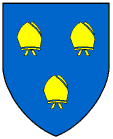
LIVES OF THE BISHOPS OF EXETER
SIMON DE APULIA. - The confusion and disturbances of the times, and the duration of the interdict from 22nd March, 1208, to 29th June, 1214, occasioned a tedious interval in the succession of our bishops. It is true that King John issued his mandate to Eugenius Archbishop of Armagh to exercise episcopal functions within this diocese (Prynne's 'Records,' vol. iii. p. 13), and that the king named also for the see Simon de Apulia, who had long been the Dean of York, and an avowed partisan of the royal pretensions against those liberties of England which the primate Stephen Langton and the barons of the realm so stoutly asserted; nay, we discover that our chapter, impatient of the delay, proceeded to elect Henry Archdeacon of Stafford to supply the vacant see; but all these attempts proved abortive. At length the king, listening to reason, recalled the clergy whom he had outlawed. This fact is reported by Bishop Stapeldon in his 'Register,' fol. 13, - "Johannes Dei gratia Rex Anglie, Dominus Hibernie, Dux Normannie et Aquitannie, Comes Ardegavie, omnibus Christi fidelibus ad quos presens scriptum pervenerit, Salutem. Sciatis per Interdictum, quod vulgariter Utlagacio nuncupatur et quod proponi fecimus contra personas Ecclesiasticas, publicè revocavimus et revocamus, et protestamur per has nostras patentes literas id ad nos de personis Ecclesiasticis nullatenus pertinere, quodque illud de cetero contra personas Ecclesiasticas non faciemus promulgari. Revocavimus etiam et revocamus utlagacionem laicorum ad negotium quod inter nos et Ecclesiam Anglie dincius versatum est pertinencium. Remittimus etiam omnia, que post interdictum Regni nostri, ab Ecclesiarum hominibus recepimus, preter Regni consuetudinem et Ecclesiasticam libertatem. Teste meipso. apud Ber xxviii. die Junii, anno Regni nostri quinto decimo" (1213).
In the same folio of the Register, Bishop Stapeldon has entered the charter of King John, granting freedom of election of prelates, and is dated from the New Temple 15th January, Nth year of his reign (1216). This was confirmed by Pope Innocent II. on 30th March, 1216. Later he indemnified them for their losses, and engaged to govern by law, and confirmed, both in the beginning and at the conclusion of the Great Charter, that the English Church should be free, and possess its rights in full integrity. Simon, above above-mentioned, a native of Apulia, one of the Neapolitan States, was admitted by the chapter and king, and confirmed and consecrated by that redoubted champion of constitutional liberty Archbishop Langton. Matthew of Westminster supposes that the consecration took place on 5th October, 1214, but the annals of Worcester date the ceremony on the 1st of that month ('Ang. Sac.' vol. i. p. 482). We find our new prelate a witness to King John's agreement to pay the dowry of Berengaria, the relict of his brother the late King Richard. He assisted at the coronation of King Henry III., then but in his tenth year, at Gloucester, on 28th October, 1216, and probably at his second coronation at Westminster on Whit Sunday, 1220. Of the acts of his episcopate we collect but slender materials. He is said to have fixed the boundaries of the parishes in this city and its immediate suburbs, which had been varying from thirty-four to twenty-eight. Several of these have long since ceased to exist; such as St. Bartholomew's, St. Peter's the Less, St. James', St. Edward's, St. Thomas', St. Cuthbert's, and St. Radegunde's, as is evident from the taxation of Pope Nicholas IV. Our prelate died on 9th September (on which day his obit was kept), 1223, and was buried in his church.
ARMS: - According to Izacke, Azure, three mitres, or, two and one. According to Westcote, Mascley, or and sable.
